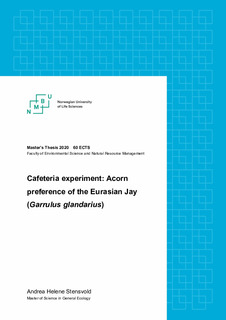| dc.contributor.advisor | Ronny, Steen | |
| dc.contributor.author | Stensvold, Andrea Helene | |
| dc.date.accessioned | 2020-10-07T11:29:27Z | |
| dc.date.available | 2020-10-07T11:29:27Z | |
| dc.date.issued | 2020 | |
| dc.identifier.uri | https://hdl.handle.net/11250/2681565 | |
| dc.description.abstract | Food hoarding is a strategy that is beneficial during food scarcity and improves the chance of survival. Seasonal fluctuations in food availability is common, and during the winter there are less food available. Eurasian Jays (Garrulus glandarius) is a common food hoarder and collects food during late summer and fall to survive during food scarcity in the winter. Jays’ main food storage is the Quercus acorns, and these are only available for a short period. It is important to cache many, but also vital acorns that can withstand a long storing period.
The main objective of this study was to see if the Eurasian jays had a preference in terms of quality of the acorns when hoarding. When collecting acorns on the ground the jays should select freshly fallen acorns to avoid mold or damages caused by ground dwelling small mammals. Further, the jays should omit acorn with holes as they can be infected by weevils (Curculio spp. and Conotrachelus spp). In this study I would like to see if the jays were selective when collecting acorns for storage. Old acorns could be moldy, acorns infected by weevils or damaged by rodents will have a higher chance of getting spoiled during storage. Thus, the jays should benefit more from collecting sound acorns.
In this study I found that jays make deliberate decisions when there are many acorns available. They preferred acorns of higher quality (i.e. intact and fresh acorns). When there are less preferable acorns available, the jays choose the less favorable acorns, such as damaged and acorns with holes. | en_US |
| dc.language.iso | eng | en_US |
| dc.publisher | Norwegian University of Life Sciences, Ås | en_US |
| dc.rights | Attribution-NonCommercial-NoDerivatives 4.0 Internasjonal | * |
| dc.rights.uri | http://creativecommons.org/licenses/by-nc-nd/4.0/deed.no | * |
| dc.subject | Eurasian Jay | en_US |
| dc.subject | Cafeteria experiment | en_US |
| dc.subject | Acorn preference | en_US |
| dc.subject | Quantity | en_US |
| dc.subject | Quality | en_US |
| dc.subject | Intact acorns | en_US |
| dc.title | Cafeteria experiment : acorn preference of the Eurasian Jay (Garrulus glandarius) | en_US |
| dc.type | Master thesis | en_US |
| dc.description.version | submittedVersion | en_US |
| dc.source.pagenumber | 32 | en_US |
| dc.description.localcode | M-ECOL | en_US |

